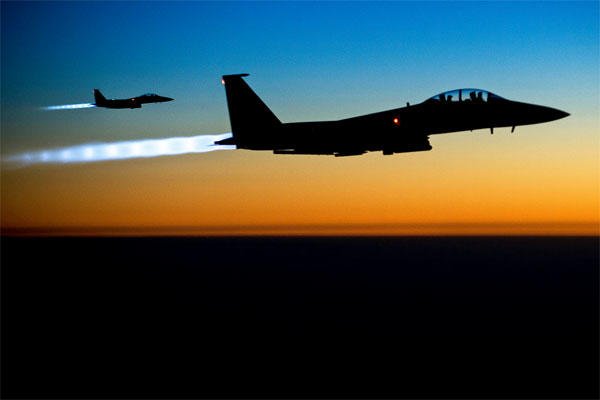The costs to date of the U.S. campaign against the Islamic State are approaching $1 billion as the pace and scope of the airstrikes in Iraq and Syria increase, according to rough estimates from the Pentagon.
Separately, Congress last week approved the Defense Department's request to reprogram $500 million from the fund for Overseas Contingency Operations to train, equip and vet about 5,000 fighters for the Syrian opposition forces.
"We're going to require additional funding as we go forward," Defense Secretary Chuck Hagel said at a Pentagon briefing Friday in addressing the mounting costs of meeting President Obama's directive to "degrade and ultimately destroy" the IS forces.
The money for the operations in Iraq and Syria has thus far come from the budget for Overseas Contingency Operations, which is separate from DoD's base budget, Hagel said. Hagel said he was working with Congress on additional funding to come from the Fiscal Year 2015 OCO budget.
Hagel said the U.S. has now conducted more than 200 airstrikes in Iraq. Since bombing began in Syria Monday night, the U.S. has carried out an additional 43 airstrikes through Friday in Syria, Hagel said.
The Pentagon has given a ballpark estimate of about $7.5 million daily for the costs of the operation, which has yet to be given a name, since President Obama on June 16 authorized sending additional troops to Iraq to assess the capabilities of the Iraqi National Security forces. By that estimate, the costs through Sept. 26 would be about $765 million.
However, Rear Adm. John Kirby, the Pentagon press secretary, said Thursday that the costs had risen since the bombing began in Iraq on Aug. 8 and were now in the range of $7-10 million daily.
It was unclear whether the costs of the 47 Tomahawk Land Attack (TLAMs) missiles that were launched in the first strikes on Syria Monday night figured in the latest calculations. The TLAM cruise missiles launched by the destroyer Arleigh Burke and the cruiser Philippine Sea cost more than $1 million apiece.
brightcove.createExperiences();
Using the $10 million daily figure since Aug. 8, and adding on the costs of the TLAMs, would put the total price tag well above $900 million by back-of-the-envelope calculating through Sept. 26.
Gordon Adams, a defense budget analyst at the Stimson Center, put the overall costs of operations in Iraq and Syria to date at well above $1 billion when factoring in the costs for transportation, aerial refueling, thousands of reconnaissance flights and personnel.
On an annual basis, "you've got to be looking at something like $15-$20 billion" in what Obama and the Pentagon have repeatedly said will be a long-term effort, said Adams, an American University professor who formerly worked at the White House Office of Management and Budget.
The escalating pace of the air campaign was exemplified by the latest statement from the U.S. Central Command on 10 attacks carried out Thursday night and Friday in Syria and Iraq by U.S. fighter and attack aircraft, and remotely piloted aircraft, against a range of targets.
In Syria, three airstrikes south and southeast of the town of Dayr Az Zawr in eastern Syria destroyed four IS tanks and damaged a fifth, CentCom said.
In Iraq, five airstrikes south and southwest of the oil town of Kirkuk destroyed three Humvees and one IS vehicle, disabled two armed vehicles and damaged one Mine Resistant-Ambush Protected (MRAP) vehicle, Centcom said.
One airstrike west of Baghdad destroyed a guard shack, an armed vehicle and a bunker, and another airstrike near Al Qaim destroyed four armed vehicles, a command and control facility and a checkpoint, CentCom said.
The Pentagon gave its most detailed accounting of the airstrikes on Sept. 10, listing a total of 162 vehicles destroyed in 154 strikes hitting 212 targets from Aug. 8 through Sept. 9 – all in Iraq.
The 162 vehicles destroyed included 88 armed vehicles, 37 Humvees, 12 armored personnel carriers, two tanks, one MRAP and 21 miscellaneous vehicles, the Pentagon said.
The strikes also destroyed a total of 21 IS weapons systems, including seven anti-aircraft artillery weapons, seven Improvised Explosive Device emplacements, one machine-gun location and one weapons cache, the Pentagon said.
IS facilities destroyed included 12 fighting positions, 10 checkpoints, one command post, one bunker and one large ground unit, the Pentagon said without further identifying the ground unit.
Since Sept. 10, and the expansion of the air campaign into Syria, the U.S. has destroyed at least an additional 21 armed vehicles, six tanks, one MRAP, several small IS ground units, and two boats delivering supplies on the Euphrates River, according to CentCom reports. The reports did not include a breakdown for the targets hit in the wide-ranging attacks in Syria on Sept. 23.
-- Richard Sisk can be reached at richard.sisk@monster.com






























